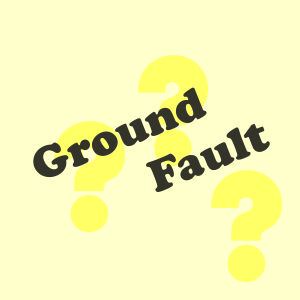Troubleshooting a ground fault is like troubleshooting anything else. The first thing to do is stop and think. Ask yourself "What are you looking at?"
Troubleshooting requires the use of a guess-and-confirm, divide-and-conquer process. There is no single way of finding the problem. Each problem is unique and often the troubleshooting procedures lead down dead end roads. If one method of troubleshooting isn't you getting anywhere, try another method.
Ground Fault Light
The ground fault light on the panel can only tell you that something is wrong; somewhere, anywhere inside the panel or in the building outside the panel, electricity is leaking to ground.
The ground fault light cannot tell you if:
- One of the batteries is cracked and leaking the electricity to the case of the panel
- Water is filling up a junction box in the trash room
- A wire is pinched inside door holder box on the third floor
The ground fault can be
- A hard ground fault where a conductor is shorted to ground somewhere in the building
- A soft ground fault where electricity leaks from the fire alarm system to ground passing through water or thin insulation
- An AC ground fault where the electricity is capacitively or inductively leaking AC power from the fire alarm system to ground or to other electrical system
In other words, after arriving on site to troubleshoot, beyond seeing that the ground fault light is on, don't look at the light again.
Meters
Instead, find a more reliable way to detect the ground fault. Start by measuring the DC voltage of the battery terminals to ground. They are connected to the plus and minus circuits of the power supply
and the battery terminals can give you a good indication of what the panel is seeing. Of course you have
to be familiar with the manufacturer and model of the panel to know what is a normal reading and what is not normal because every model is a little different.
If that doesn't work, use another method.
Multiple Meters
There are 4 types of meters that are commonly used in troubleshooting ground faults.
- DC Volt Meter
- AC Volt Meter
- Standard Ohmmeter
- Insulation Tester (Ohmmeter using internal voltage of greater than 15 volts but less than 40 volts)
There is no standard method, guess what meter to use and confirm whether you can see the ground fault.
Divide-and-Conquer
Troubleshooting uses a Divide-and-Conquer technique: put a division between the part of the system that's good and the ground fault. Take pictures and mark wires to make sure you can get them back exactly where you disconnected them, but remove loops of wires and check to see if the ground fault goes away.
Remember - don't use the ground fault light-- it's a real bad troubleshooting indicator; use the meter to see if the ground fault is gone.
Patience
Using the guess-and-confirm, divide-and-conquer process, the ground fault can and eventually will be found. The hard part is acquiring the required patience for the troubleshooting -- have patience and patience will come.
After finding and fixing dozens to hundreds of ground faults, you will be able to find most ground faults quickly.
Douglas Krantz
